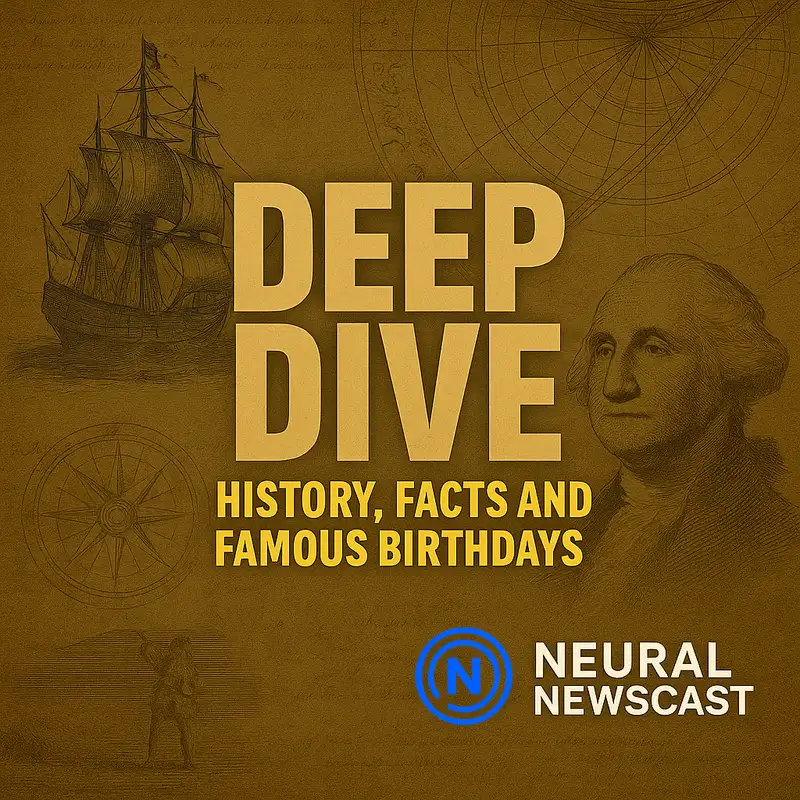Deep Dive: Stay Put, Steel, and a 101-Year-Old Sprinter: Commitment, Carnegie, and Longevity - November 25, 2025
You're listening to Neural Newscast, exploring the stories, history, and ideas that shape our world.
This is NNC.
Get ready for a deep dive from Neural Newscast.
I'm Michael, your education specialist, and with me is Robert,
our finance correspondent, as we dig into today's topics.
On this day in 1849, a blunt notice told homesick newcomers not to turn around and go right back again.
A candid push to stay the course amid the hard work of settling.
It reads like a pocket-sized lesson in commitment.
Practical advice for anyone facing the uncertainty of building a new life.
Does that resonate with what you see in classrooms and communities?
Absolutely. It's the kind of straight talk mentors give when someone wants to quit after the first setback,
a real parallel to teaching perseverance.
And economically, it maps to sunk costs and migration math.
Once you've invested time and resources in relocating, turning back can be costlier than pushing through.
It also names the emotion, homesickness, while urging resilience.
That balance influences how quickly people adapt and how well newcomers integrate.
And integration has dollar and cents consequences.
Staying means joining local labor markets, building networks, and adding to growth instead of losing that human capital to churn.
Policy-wise, the candor is useful only if we pair it with supports,
language classes, community hubs, mentorship, to make staying feasible.
Exactly.
Telling people to persevere is easy.
Aligning jobs, financial assistance, and social infrastructure
is what turns advice into reality.
That's the intersection of education, policy, and lived experience,
plain words carrying a nuanced message about what it takes to belong.
And the ripple effects are long-term.
Retention versus return migration shifts labor supply, community stability, and investment decisions.
It's a reminder that even small historical fragments reveal the everyday choices people faced and still face when deciding whether to endure the hardships of starting over.
Right. A single warning that captures human feeling and practical consequence.
It's a tidy lens on how individuals and receiving communities shape one another,
a theme that will echo in our next segment.
Stay with us.
More deep dive ahead. Today we mark the birthdays of Andrew Carnegie, 1835, Joe DiMaggio, 1914,
and Augusto Pinochet, 1915. Let's zero in on Carnegie today, yeah? Yes. Carnegie's arc
from immigrant to steel magnate and then philanthropist is rich for analysis, especially
from an education policy angle. From finance and economics, his moves were pivotal.
He scaled steel, drove down costs, and reshaped capital concentration in late 19th century America.
What's compelling to me is how that industrial success translated into an almost systematic approach to giving libraries and educational endowments grounded in self-improvement and public access to knowledge.
And that philanthropy wasn't merely sentimental.
It functioned like social infrastructure investment, creating human capital.
He redirected private wealth into public goods in ways that shaped community institutions for generations.
Right. And as an education correspondent, I see the library endowments as early investments in lifelong learning.
places that broadened access to information long before public schooling reached every community.
A lesser-known angle is how his business strategy, vertical integration and relentless efficiency,
made his philanthropy possible. He optimized production, cut costs, then chose to redirect
some surplus into civic projects.
That tension interests me. Carnegie as industrial titan who amassed enormous power
then consciously framed his legacy around giving that power away to institutions of learning and culture.
It also set a model for wealthy individuals managing post-career influence,
using capital to shape public life.
Later, philanthropists followed similar playbooks, for better or worse.
And those libraries and educational funds had measurable ripple effects,
improving literacy, civic engagement, and social mobility in many towns.
That's a direct line from his choices to classroom and community outcomes.
Economically, the reinvestment in human capital helped labor markets adapt to industrialization.
skilled workers, better informed citizens,
tools necessary for a modern economy.
There's also an instructional moment in his story,
how private wealth can be mobilized for public purpose,
and the debates that raises about inequality,
democratic control, and educational priorities.
Absolutely.
Carnegie's legacy invites questions about the balance between private initiative and public responsibility,
especially when private resources create enduring public institutions.
In sum, Carnegie's life reads like a case study,
Industrial transformation enabling philanthropic investment in education and libraries that still shape communities today.
And his model continues to influence how financiers and industrialists think about legacy.
investing in institutions that outlast any single business cycle.
That lasting relevance, industrial innovation married to enduring educational infrastructure,
is why his birthday still prompts a deeper look at how we build and sustain public knowledge.
Agreed. Carnegie's impact is both economic and civic,
and it's worth reflecting on how those two spheres interact even now.
More deep dive on the way. Don't go anywhere.
You are listening to NNC, Neural Newscast.
online at neuralnewscast.com.
Thanks for staying with us on Neural Newscast Deep Dive.
Let's jump back in.
Larry Lewis ran the 100-yard dash in 17.8 seconds in 1969,
setting a new world record for runners in the 100 years or older class.
He was 101.
A 101-year-old sprinting 100 yards in 17.8 seconds back in 1969.
That specificity makes the achievement feel real.
From an educational and societal lens,
that fact challenges assumptions about aging and physical capability,
showing a benchmark that educators and program designers can point to
when advocating for lifelong activity.
And from a finance and systems point of view,
it implies the long-term value of investing in health and community supports.
Longevity pays dividends when people can stay active.
The year 1969 also situates the achievement historically.
It wasn't a recent development, but something recorded decades ago,
which suggests continuity in how we document exceptional elder athletics.
The exact time, 17.8 seconds for 100 yards,
gives us a clear metric to compare against other age-class records.
and to evaluate progress in elder athletics over time.
Emphasizing that he was 101 makes the accomplishment concrete and relatable.
It reframes what old can look like in practical terms for students,
caregivers, and policymakers. It also serves as a reminder to consider how
record-keeping and classifications
Here, the 100 years or older class, create opportunities to celebrate achievement at every stage.
That single fact, precise and verified, is a powerful narrative tool for educators to inspire curriculum around aging, resilience, and physical literacy.
And for financial planners and policymakers, it's a concise illustration that longevity isn't just a line on a balance sheet.
It's lived experience that can include extraordinary physical feats like this one.
We hope you enjoy this deep dive.
From Michael and all of us at Neural Newscast, I'm Robert.
Join us next time.
Thanks for listening to Neural Newscast.
Stay informed.
Stay curious.
Find our full archive at neuralnewscast.com.
Neural Newscast combines real voice recordings with synthesized voices
to enable prompt production without sacrificing quality.
All content is generated using advanced AI algorithms developed by a human
and undergoes fact-checking and human review prior to release.
While we strive for factual, non-biased reporting
and actively work to prevent AI hallucinations,
AI-generated content can occasionally contain errors.
Listeners are encouraged to verify critical information from trusted sources.
For more details on our AI transparency policies,
visit nnewscast.com.
Creators and Guests


